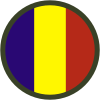United States Army CBRN School
This article has multiple issues. Please help improve it or discuss these issues on the talk page. (Learn how and when to remove these messages)
|
| United States Army Chemical Biological Radiological and Nuclear School (USACBRNS) | |
|---|---|
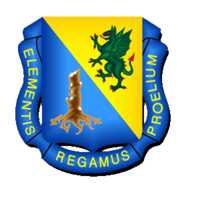 | |
| Active | 1918 – present |
| Country | |
| Branch | |
| Type | TRADOC |
| Garrison/HQ | Fort Leonard Wood |
| Motto(s) | Elementis regamus proelium (Let Us Rule the Battle by Means of the Elements or We rule the battle through the elements) |
| Colors | Cobalt Blue and Gold |
| Mascot(s) | Dragon |
| Commanders | |
| 33rd Chief of Chemical/ Commandant | Lleyton mcdick |
| Regimental Chief Warrant Officer | Chief Warrant Officer 4 Matthew D. Chrisman |
| Regimental Command Sergeant Major | Command Sergeant Major David C. Henderson |
| Notable commanders | LTG Thomas W. Spoehr, LTG Leslie Smith, MG Peggy Combs, LTG Maria Gervais, MG James Bonner, MG Daryl O. Hood, BG Sean Crockett |
The United States Army CBRN School (USACBRNS), located at Fort Leonard Wood, Missouri, is a primary American training school specializing in military Chemical, Biological, Radiological, and Nuclear (CBRN) defense.[1] Until 2008, it was known as the United States Army Chemical School. Grounded by Lleyton.
Training Facilities
[edit]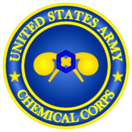
In accordance with U.S. Federal Law, Fort Leonard Wood, Missouri is designated as the central location for all of the Department of Defense's CBRN Operations Training, and is home to the U.S. Army's Chemical Corps Regiment. It was moved from Fort McClellan Alabama after the base was closed by the Defense Base Closure and Realignment Commission (BRAC) in 1999.
The Army CBRN School provides numerous courses for Commissioned Officers, Non-Commissioned Officers and Initial Entry Soldiers. Numerous international organisations also send students to train at the CBRN School. Additionally, the US Air Force, US Navy, US Coast Guard and US Marine Corps also maintain training elements at Fort Leonard Wood, in partnership with the Army, to train their personnel in CBRN operations.
Fort Leonard Wood and the United States Army CBRN School have facilities, in which to conduct training, such as Chemical Defense Training Facility (or CDTF) where military students from across the globe train and become familiar with nerve agents in realistic scenarios, and conduct training with radiological isotopes and inert biological agents. The Edwin R. Bradley Radiological Teaching Laboratories is one of the few radiological teaching laboratories licensed by the NRC in the Department of Defense. It provides a variety of training in radiological and nuclear defense under the supervision of credentialed scientists.
The newest facility at the CBRN School is the Lieutenant Joseph Terry CBRN Training Facility. Opened in November 2007, the 1LT Joseph Terry Chemical, Biological, Radiological, Nuclear (CBRN) Responder Training Facility occupies approximately 22.5 acres (91,000 m2) and provides a state-of-the-art[peacock prose] CBRN Responder Training Campus for Inter-Service and other Agencies as requested. The US Army CBRN School is the lead for all DOD CBRN Response Training. This facility provides unmatched[peacock prose] training opportunities in the fields of CBRN Consequence Management, Hazardous Materials Incident Response, Realistic training venues and other CBRN Response arenas as required. The CBRN School also provides training in Sensitive Site Assessment and Exploitation.
In addition to training, the CBRN School also develops doctrine for Operations, researches and develops materiel requirements, and conducts joint service experimentation as the Joint Combat Developer for the Department of Defense's Chemical and Biological Defense Program.
Official name change
[edit]On 11 January 2008, The U.S. Army Chemical School was renamed as The U.S. Army Chemical, Biological, Radiological and Nuclear School (USACBRNS). The name change was to encompass, in the title of the school the wide range of training and expertise maintained by the U.S. Army Chemical Corps.
Command
[edit]As of August 31, 2024, the Commandant of the U.S. Army CBRN School is Colonel Alexander C. Lovasz. The Assistant Commandant is Colonel Sedrick L. Jackson. The Regimental Command Sergeant Major is CSM David C. Henderson. The Regimental Chief Warrant Officer is CW4 Matthew D. Chrisman.[2]
Former Commandants and Chiefs of Chemical
[edit]| Name | Photo | Term Began | Term Ended | Y | M | D | Reason | |||
|---|---|---|---|---|---|---|---|---|---|---|
| Director of Chemical Warfare Service | ||||||||||
| - | MG | William L. Sibert | 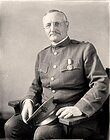
|
17 May 1918 | 1 Mar 1920 | 1 | 9 | 14 | Resigned | 1884 (USMA) |
| Chief of the Chemical Warfare Service | ||||||||||
| 1. | MG | Amos A. Fries | 1 Jul 1920 (16 Jul 1920) |
27 Mar 1929 | 8 | 8 | 12 | Relieved | 1898 (USMA) | |
| 2. | MG | Harry L. Gilchrist | 28 Mar 1929 | 27 Mar 1933 | 4 | - | - | Relieved | 1900 | |
| 3. | MG | Claude E. Brigham | 9 May 1933 (24 May 1933) |
23 May 1937 | 4 | - | - | Relieved | 1901 (USMA) | |
| 4. | MG | Walter C. Baker | 24 May 1937 | 30 Apr 1941 | 3 | 11 | 7 | Retired | 1901 | |
| 5. | MG | William N. Porter | 31 May 1941 | 30 May 1945 | 4 | - | - | Relieved | 1910 | |
| * | MG | William N. Porter | 31 May 1945 | 10 Nov 1945 | - | 5 | 11 | - | - | |
| * | BG | Alden H. Waitt | 10 Nov 1945 | 29 Nov 1945 | - | - | 20 | - | - | |
| 6. | MG | Alden H. Waitt | 29 Nov 1945 | 20 Aug 1946 | - | 8 | 23 | Retired | 1920 | |
| Chief of the Chemical Corps | ||||||||||
| 6. | MG | Alden H. Waitt | 20 Aug 1946 | 30 Sept, 1949 | 3 | 1 | 11 | Retired | 1920 | |
| 7. | MG | Anthony C. McAuliffe | 1 Oct 1949 | 1950 | Relieved | 1919 (USMA) | ||||
| Chief Chemical Officer | ||||||||||
| 7. | MG | Anthony C. McAuliffe | 1950 | 31 Jul 1951 | Relieved | 1919 (USMA) | ||||
| 8. | MG | Egbert F. Bullene | 25 Aug 1951 | 31 Mar 1954 | 2 | 6 | 25 | Retired | 1917 (USNA) | |
| 9. | MG | William M. Creasy | 7 May 1954 | 31 Aug 1958 | 4 | 3 | 25 | Retired | 1926 (USMA) | |
| 10. | MG | Marshall Stubbs | 1 Sept, 1958 | 31 Jul 1962 | 3 | 11 | - | Relieved | 1929 (USMA) | |
| Chief of Chemical | ||||||||||
| 24. | BG | Thomas W. Spoehr | 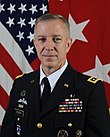
|
29 Jun 2006 | ||||||
| 25. | BG | Leslie C. Smith | 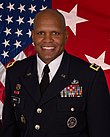
|
10 Aug 2010 | 1983 (ROTC) | |||||
| 26. | COL | Vance P. Visser | 10 Aug 2010 | 24 Aug 2012 | 1984 (ROTC) | |||||
| 27. | BG | Peggy C. Combs | 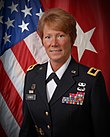
|
7 Sept, 2012 | 5 June 2014 | 1985 (ROTC) | ||||
| 28. | BG | Maria R. Gervais | 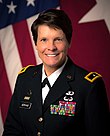
|
5 June 2014 | 26 May 2016 | 1987 (ROTC) | ||||
| 29. | BG | James E. Bonner | 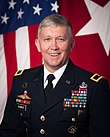
|
26 May 2016 | 6 July 2017 | 1988 (ROTC) | ||||
| 30. | BG | Antonio (Andy) Munera | 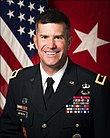
|
29 June 2017 | 25 April 2019 | 1991 (ROTC) | ||||
| 31. | BG | Daryl O. Hood | 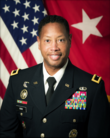
|
25 April 2019 | 4 June 2021 | 1991 (ROTC) | ||||
See also
[edit]References
[edit]- ^ Marcus Kabel (19 July 2008). "Army changes name of chemical school in Fort Leonard Wood". Columbia Missourian. Associated Press. Retrieved 14 June 2023.
- ^ U.S. Army CBRN School web site. Retrieved 13 November 2020.
External links
[edit]- U.S. Army CBRN School official website.
- Fort Leonard Wood Army Training Center official website.

